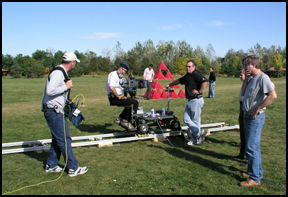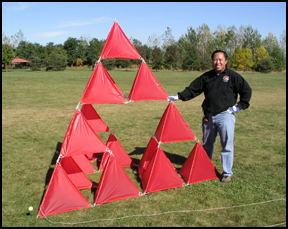Filming the Flight of the Bell Tetrahedral Kite for CBC-TV
Alexander Graham Bell - "The Greatest Canadian!"
As part of the TV documentary series "The Greatest Canadian", CBC-TV required a Bell tetrahedral kite as a visual prop to explain some of Alexander Graham Bell's work in early aviation.
 A 16 cell tetrahedral kite was built by Morris Canning of Parrsboro, NS (shown left) to be used in the segment about Bell's kites. The remainder of the story of Bell's use of kites is revealed through the use of archival photos from the A.G. Bell Museum in Baddeck, NS.
A 16 cell tetrahedral kite was built by Morris Canning of Parrsboro, NS (shown left) to be used in the segment about Bell's kites. The remainder of the story of Bell's use of kites is revealed through the use of archival photos from the A.G. Bell Museum in Baddeck, NS.
I was contacted in late July of 2004 by Patti-Ann Finlay, a CBC researcher assigned to the project, to discuss the role of tetrahedral kites and possibly build one for the documentary. My commitments to our local kite festival prevented me from actually building the kite. So Morris Canning undertook the construction of the kite and shipped it to me for my work with the CBC documentary crew. It was my task to assemble it, test fly it, teach CBC on-air staff to fly the kite and manage its use within the documentary.
The opportunity to work on a project like this would be exciting to any kiter and I eagerly entered into the project. Patti-Ann and I consulted on the phone on a number of occasions.
 The kite that Morris built arrived on September 24th. It is an elegantly constructed kite and Morris clearly is a very fine kite builder. The complicated corner connections on the kite are nicely made out of vinyl tubing. They are surprisingly effective at giving the kite structural integrity at the complicated joints of tetra cells. The spars are of 3/16" hardwood dowel which make them light, yet reasonably strong. The sails are of red ripstop and they are very nicely sewn. Red was chosen to emulate the red silk used by Bell in his tetrahedral kite experiments at Beinn Bhreagh in Baddeck, N.S.
The kite that Morris built arrived on September 24th. It is an elegantly constructed kite and Morris clearly is a very fine kite builder. The complicated corner connections on the kite are nicely made out of vinyl tubing. They are surprisingly effective at giving the kite structural integrity at the complicated joints of tetra cells. The spars are of 3/16" hardwood dowel which make them light, yet reasonably strong. The sails are of red ripstop and they are very nicely sewn. Red was chosen to emulate the red silk used by Bell in his tetrahedral kite experiments at Beinn Bhreagh in Baddeck, N.S.
The date of filming was set for Thursday, September 30, 2004 at Milliken Park in the borough of Scarborough, city of Toronto. Upon my arrival at 11:00 a.m., I set up two perimeter wind ribbons on twenty foot telescoping poles to help us determine wind direction and speed during the takes for the flight sequence. Winds were light and intermittent. However, when there was a bit of wind it seemed that we would be able to carry out the flights according to plan.
 I completed the assembly of the kite and staked it to the ground to avoid an unwanted lift off. The setup of the film equipment was undertaken by CBC's technicians. It was at that moment that I realized the complexity of the task. The camera crew required a ninety foot track to be set up for their camera sled to ensure smooth filming as they provided motion and panning to the shots. Immediately I worried about the variability of wind direction. It was no easy task to set up the track, camera and sound equipment and if the wind did not hold in the general direction of the established layout we would be in serious trouble.
I completed the assembly of the kite and staked it to the ground to avoid an unwanted lift off. The setup of the film equipment was undertaken by CBC's technicians. It was at that moment that I realized the complexity of the task. The camera crew required a ninety foot track to be set up for their camera sled to ensure smooth filming as they provided motion and panning to the shots. Immediately I worried about the variability of wind direction. It was no easy task to set up the track, camera and sound equipment and if the wind did not hold in the general direction of the established layout we would be in serious trouble.
Ask any kite flyer about constant wind direction and they will tell you that there are no guarantees. There may be prevailing winds and there may be on-shore/off-shore wind conditions that are typical, but there are no guarantees on constancy of wind direction for any one day or period in a day. I was quietly worried.
 At about 12:30 p.m. my good friend Gary Mark of TKF arrived to take some photos of the event as well as to lend some encouragement and support. It was not long before Gary was an active and involved member of the kite crew and a highly valuable additional resource consultant. We decided that a test flight would be useful since I had only flown the kite in a four cell configuration to check some basic flight characteristics. I had never actually handled Morris' tetrahedral in its full sixteen cell configuration.
At about 12:30 p.m. my good friend Gary Mark of TKF arrived to take some photos of the event as well as to lend some encouragement and support. It was not long before Gary was an active and involved member of the kite crew and a highly valuable additional resource consultant. We decided that a test flight would be useful since I had only flown the kite in a four cell configuration to check some basic flight characteristics. I had never actually handled Morris' tetrahedral in its full sixteen cell configuration.
We walked the kite out for a very long launch due to the light wind conditions. So far so good - the wind direction remained aligned with the camera track location.
A tug, a few backward steps after Gary hand launched the kite and the kite was airborne. The kite climbed quickly and steadily and lofted into a stable position. Spontaneously the crew, director and management team broke into applause. The kite hung there for a few seconds and then the breeze died and I reeled in as quickly as possible to keep tension on the kite and bring it in for a soft landing. Gary broke into a sprint to soften the impact of the kite on the ground. He demonstrated good speed and agility and assisted the landing nicely.
Morris Canning constructed the kite lightly, but well. His intention, I figured, was to ensure good balance and provide a light enough framing structure to ensure easy flight in lighter winds. That was a good decision for we did not have strong winds during the day. Generally top wind speed, when the wind was up, was estimated at about 10-12 km per hour. Fequently it was much lighter than that and flying the kite required some vigorous pulling in of line to maintain elevation for the brief ninety second vidoe sequence .
Morris likely did not realize that we would have to accomplish about 15 flights during the day to ensure a good take for use in the documentary. All of the flights required some skilled line handling on the bridle and frame for launch. In addition delicate landings were necessary when the winds failed.
To ensure that the kite frame would not break we raced out to grab the kite and prevent it from dashing into the ground on each occasion. Gary Mark demonstrated 'great wheels' and proved that he is considerably younger and fitter than I am. Gary was assisted by Patti-Ann Finlay and Andre Czernohorsky of CBC. Great 'saves' were made on a number of occasions. However, there were a few crunches resulting in some broken spars. In addition, launching the kite seemed to put a good deal of strain on the frame and a few spars were broken at the start of some of the flights.
Each break required some disassembly of the kite to get at the cell that suffered the damage. Spar repairs were made, reassembly accomplished and subsequent "takes" were set up. As everyone knows, the Director wants to have several choices on tape from which to make a final selection.
 In all, we did ten takes of on-screen narrator Evan Soloman of CBC Newsworld explaining the features of the tetrahedral kite, Bell's reasons for choosing the tetrahedral structure, and a demonstration flight. The kite performed well each time.
In all, we did ten takes of on-screen narrator Evan Soloman of CBC Newsworld explaining the features of the tetrahedral kite, Bell's reasons for choosing the tetrahedral structure, and a demonstration flight. The kite performed well each time.
At the end of shooting the sequence with dialogue we readied the kite for one final flight with Evan not doing any narration. The purpose for the final flight was to get some unusual camera angles of the kite and Evan as the kite flyer. It was thought that these flight sequences might be used when the credits are shown for the documentary.
Following a long flight sequence the camera crew were satisfied and, on cue, the light winds died and the kite dropped. This time a few broken spars ensured that I would have some work at home to put it back in pristine condition. However, it had done it's job and Morris' fine version of the tetrahedral more than stood up to the rigorous multi-flight test.
The sequence will be part of the Bell documentary to air on November 15, 2004. For more information on "The Greatest Canadian" series, visit the CBC site dedicated to the project. Within the overall site on the series is a section devoted to Alexander Graham Bell.
My appreciation is extended to Patty-Ann Finlay of CBC-TV for including me in the work on this project. My hat is off to Morris Canning for his kite building skills and my good friend Gary Mark of Oakville, ON for helping out with his fine flying skills. Thanks also to host Evan Soloman and the entire crew for making Gary and I feel so special and involved. It was truly an interesting day of kiting!